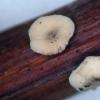
02-12-2025 18:59
This pair of ascos 2.5cm across were on recently b

02-12-2025 19:25
Buckwheat PeteHello, can anyone identify this hairy fungus growi

30-11-2025 12:53
 Edvin Johannesen
Edvin Johannesen
White short-stipitate apothecia found on thin twig

30-11-2025 10:47
 William Slosse
William Slosse
I recently found a collection of small Peziza sp.

27-11-2025 12:01
Thomas Læssøehttps://svampe.databasen.org/observations/10496727

27-11-2025 11:46
Thomas Læssøehttps://svampe.databasen.org/observations/10493918
Calycina sp. 1 : C. subparilis ?
Nicolas VAN VOOREN,
31-10-2009 18:36
 Bonjour.
Bonjour.Voici les données d'une récolte d'un Calycina que je pense être C. subparilis d'après la clé de Zotto. Je suis intéressé par une confirmation.
Apothécies substipitées, discoïdes avec un petit ombilic, hyménium blanchâtre ou ivoire ; surface externe concolore, très finement furfuracée. Ø 0.9-1.2 mm
Excipulum de textura globulosa/subangularis, à hyphes Ø -> 12 µm, mais avec des cellules plus allongées et émergentes sur la partie extérieure. Asques avec crochet, 8 sp. ± bisériées, pars sporifera pratiquement sur toute la longueur, 65-70 x 4.8-6 µm, anneau apical IKI rb. Paraphyses sans vacuoles. Spores fusoïdes, avec 1 cloison (y compris dans l'asque), avec généralement 2-3 grosses gouttes réfringentes et d'autres plus petites, (11) 12-15 x (16) x (2) 2.5-3 µm
Hans-Otto Baral,
31-10-2009 21:15

Re:Calycina sp. 1 : C. subparilis ?
Hi Nicolas
do you mean subparilis or subherbarum? :-)
subparilis has no croziesr and much wider spores. Your drawing looks like wide spores but 12-15 2.5-3 means quite narrow spores. Also subparilis grows on thicker wood and has asci without croziers. What is the substrate here?
Zotto
do you mean subparilis or subherbarum? :-)
subparilis has no croziesr and much wider spores. Your drawing looks like wide spores but 12-15 2.5-3 means quite narrow spores. Also subparilis grows on thicker wood and has asci without croziers. What is the substrate here?
Zotto
Nicolas VAN VOOREN,
01-11-2009 10:00

Re:Calycina sp. 1 : C. subparilis ?
Thank you Zotto.
OK, for C. subherbarum. The paraphyses I saw on this collection were probably dead.
The substrat is a dead herbaceous stem (I cannot identify the plant).
OK, for C. subherbarum. The paraphyses I saw on this collection were probably dead.
The substrat is a dead herbaceous stem (I cannot identify the plant).

